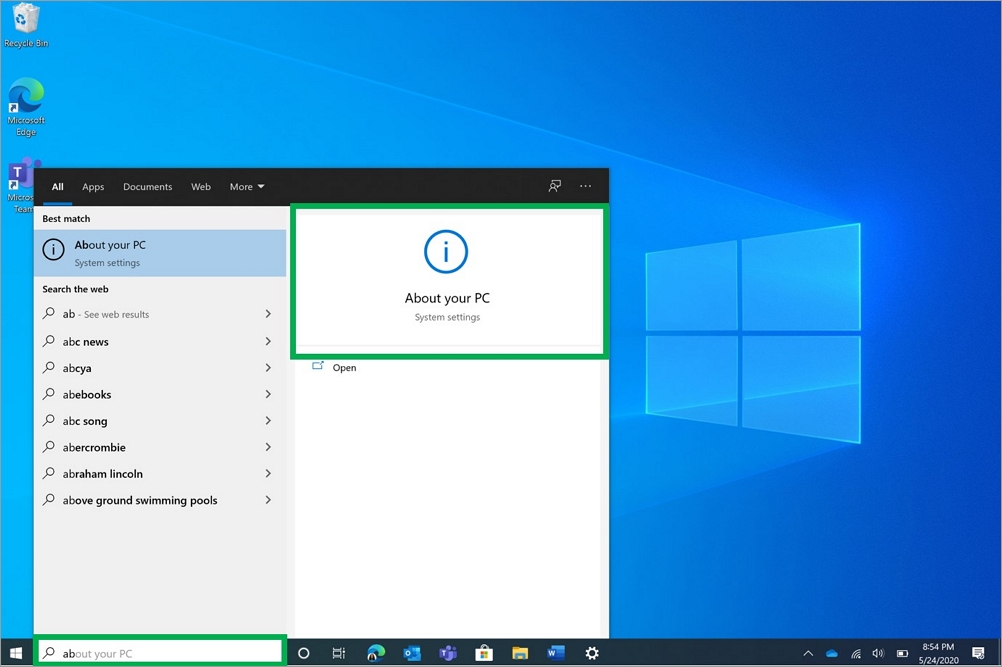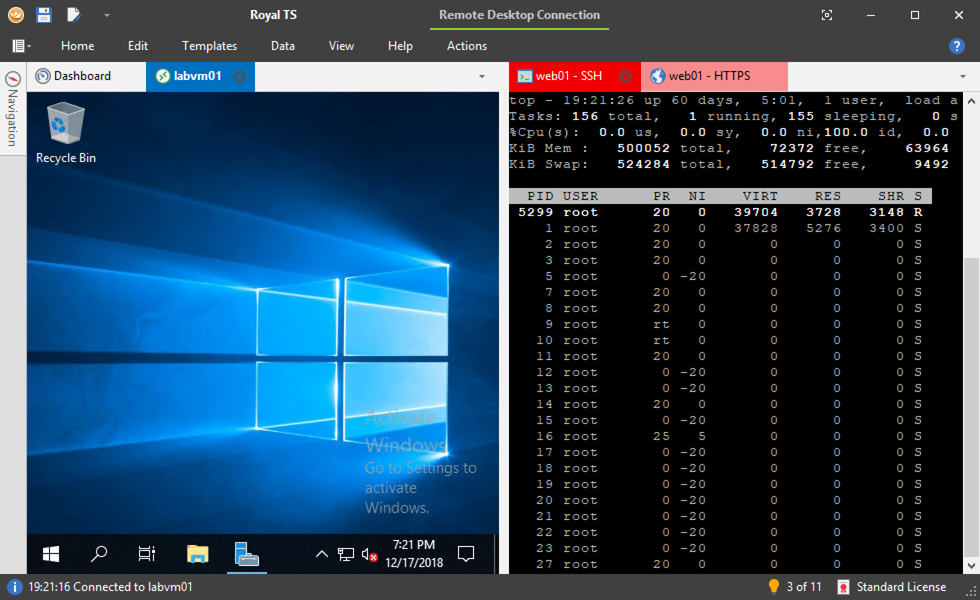Windows Remote Desktop can be used on Windows from XP up through Windows 10. How to Use Remote Desktop on Windows 10 However, while all versions of Windows can connect to other computers that have incoming connections enabled, not all Windows versions can act as a host (i.e. Accept incoming remote access requests). Download this app from Microsoft Store for Windows 10, Windows 8.1, Windows 10 Mobile, Windows Phone 8.1, Windows 10 Team (Surface Hub), HoloLens. See screenshots, read the latest customer reviews, and compare ratings for Microsoft Remote Desktop. My laptop was on Windows 8 Pro My desktop was on Windows 10 Technical Preview (TP). Hence, why Windows 10 looks more Windows 8 than the 10 that we have now. The screen shots were taken from the side of my laptop. So you see Remote Desktop running in a window. Yes, you can make it full screen. First screen shots shows my desktop running Steam. Mar 26, 2018 About use case, from what I am told, the users have to login to Windows 10 desktops, and the main use would be a custom browser to be installed on the desktop, that will be used to deliver examinations to anyone logging into the client. So this would most likely be some kind of Windows 10 kiosk usage.
- Best Rdp Client For Windows 10 Downloads
- Better Rdp Client Windows 10
- Itunes Download For Windows 10
- Mremoteng Vs Rdcman
- Open Source Remote Desktop Client
- Mcafee For Windows 10
There are numerous reasons behind the use of remote desktops, which play a crucial role in today’s IT software ecosystem. If you’re providing support services for desktops and laptops, working with virtual servers or applications, or working in a company in which the offices are distributed nationally or internationally, you’ll be using remote desktop software.
Windows systems come with a built-in protocol for remote connections. Microsoft Remote Desktop Protocol (RDP) provides a graphical interface through which users can connect to a remote computer via a network connection. However, there are now several RDP alternatives on the market, designed to address potential functionality gaps. My top recommendation for a remote desktop alternative is SolarWinds® Dameware®, offering an on-premises and a cloud version, both designed to facilitate the easy handling of remote desktop issues.
What Is RDP?
RDP, short for Remote Desktop Protocol, is a protocol developed by Microsoft. It allows you to connect to another computer using a graphical user interface, so you can interact with the remote machine. You can control a remote desktop session and delete or copy text between applications running on the host machine and the guest machine. This helps with remote troubleshooting and issue resolution, so IT staff won’t need to go directly to the computer experiencing the problem.
However, with the rise of cybercrime have come warnings about the security of RDP. Moreover, several RDP alternatives have appeared on the market, many of which offer much more in the way of capabilities depending on your specific needs. If you’re looking for an alternative to Remote Desktop Protocol, consider the options below.
Best Remote Desktop Alternatives
Best Rdp Client For Windows 10 Downloads
Dameware Remote Support is a significant upgrade from RDP, designed to provide all of the same features as the Microsoft protocol along with added features that help enhance problem resolution and cybersecurity on remote devices. Like RDP, DRS makes it easy to connect remotely to other computers. With additional features built to go beyond those in RDP, DRS makes for a comprehensive and easy-to-use remote desktop connection manager alternative.
Like RDP, DRS offers multi-platform remote access, with support for Mac, Windows, and Linux computers. In an enterprise setting, for example, it can work across your Windows desktops, Linux servers, and Mac devices staff may connect with from home. That includes providing access to computers from Android and Apple devices including tablets, which are not supported in RDP.
Both RDP and DRS offer the ability to connect over both the internet and LAN. This is particularly important in DRS since this, along with the tool’s other features, can help facilitate straightforward troubleshooting. With both DRS and RDP, you can remotely reboot entire systems or stop services and processes if something is causing the system to fail. DRS is designed to go beyond that, though—it includes system tools that allow you to fix problems on a computer you’re connected to remotely without having to interrupt the user’s session. DRS, like RDP, also lets you directly copy and paste—or delete—text in applications between the host and guest machine.
Dameware Remote Support offers a free trial for up to 14 days.
Another good option to consider, particularly if you are working in a cloud-based IT environment, is Dameware Remote Everywhere. DRE is in some ways the same tool as DRS, but it offers slightly different features.
First, DRE is designed for use in the cloud, which means it is accessible from any compatible device with internet connection. RDP also connects to remote devices over the internet; however, a distinction between the two tools may arise when it comes to speed. While DRE has a particular focus on speed, with remote connections typically established within eight seconds, RDP typically has slower connection times.
DRE also includes additional features for taking screenshots and recording during remote sessions and connecting with the user through VoIP or video call. RDP doesn’t natively include these features, with the only way to record or take screenshots during remote sessions is by implementing outside tools and procedures.

Dameware Remote Everywhere offers a free trial for 14 days.
Royal TS provides support for RDP and other connection protocols, including VNC, SSH, FTP and SFTP, and connection through web-based interfaces. Like other professional tools, it includes credentials management and sharing features, so you don’t need to log in repeatedly. It also provides remote troubleshooting capabilities.
One of the unique features of Royal TS is it can create command tasks and key sequence tasks, which allow you to create your own tasks and automate parts of your troubleshooting processes. For example, ping and traceroute are built in, and you can automate repetitive tasks, so you can execute them as soon as a connection is established.
Royal TS distinguishes itself from RDP when it comes to credential allocation. While RDP lets you save and share credentials between teammates, it does not let you save credentials tied to a remote desktop gateway. Not only does Royal TS let you create objects and folders and dynamically allocate credentials, it also lets you link folders and connections to inherit credentials. These features are designed to facilitate strong access and security measures.
Royal TS offers a free download of its “Lite” version, which allows up to 10 connections and 10 credentials. The paid version is also available through the developer’s website.
If you’re looking for an RDP alternative specifically for use with Mac computers or mobile devices, Edovia produces many products, including several versions of Screens.
Screens iOS allows you to control other computers from your iPhone or iPad, using an SSH connection. It can connect to Mac, Linux, Raspberry Pi, and Windows PCs, using the Screens Connect app. You can view the current session (e.g., for troubleshooting), or start a new session.
Screens Mac provides the same capabilities as Screens iOS, but from Mac OS systems.

There is a free trial of Screens Mac, and a free version, called Screens Express, with limited usage for specific circumstances. Screens Mac is downloadable through the Edovia website. You can buy Screens iOS from the App Store.
Terminals is an open-source remote desktop manager intended to manage the problem of controlling multiple connections simultaneously. It integrates RDP as one of the protocols it supports, but also works with VNC, VMRC, SSH, Telnet, RAS, Citrix ICA, and HTTP and HTTPs.
It includes several basic features to make the remote connection experience smoother, including a multi-tab interface, resizable windows, customizable toolbars, and a connections history, so you can see which machines you have connected to recently. You can also search by server name and look at protocol notes. This tool is high-quality, but basic, and it may not be suitable for a large enterprise needing a greater set of features for IT support and troubleshooting management.
Better Rdp Client Windows 10
You can download Terminals for free on Github.
As a free tool, Terminals is a mRemoteNG alternative. For a comparison of mRemoteNG vs. Terminals, look at both repositories in Github to view the documentation, as it gets a little technical.
How to Choose an RDP Alternative
There are several factors behind choosing a good RDP alternative, but your decision will in large part depend on the number of connections you’re dealing with, the type of information in your environment (e.g., if it’s sensitive and needs extra security), and the size of your enterprise.
A free or open-source tool might be suitable in a low-risk, small business environment, in which case Terminals is a good choice. For a large enterprise or a company with sensitive data, invest in a professional tool such as Dameware Remote Support or Dameware Remote Everywhere.
Having reconsidered the characteristics and tried almost all RDP-clients on Linux, I can say with confidence that FreeRDP is the best. At what the best without use of any superstructures of type Remmina. I, as a user, do not like it when the remote desktop opens in a window with scrollbars and completely incomprehensible resolution. Wide fields of windows eat up some space on which the remote desktop could turn. Some clients can not work with a common clipboard, which is also inconvenient. Having tested and fairly tested different clients, I settled on FreeRDP. You can install it in Ubuntu using the command apt-get install freerdp-x11. It starts simply. In the console we type xfreerdp -k en-us -T 'Computer name' -a 32 -x l -z -u darkeye -g 1366x680 --sec rdp --plugin cliprdr 192.168.1.24 and by entering the password to connect to the desktop of the remote windows. As you can see, there is nothing complicated in this.
Let's look at each option of the command:
-k en-us keyboard - Select a language keyboard layout on the remote machine
-T 'Computer name' Here everything is clear it's just the name of the connection
-a 32 monitor color depth 8, 15, 16, 24, 32 bit
-x l channel l (lan) performance. The most productive and includes all the effects and desktop background image

-z enable compression inside the encrypted channel RDP
-u darkeye login on the remote machine
-g 1366x680 necessary screen resolution.
--sec rdp authorization method: RDP, TSL или NLA

--plugin cliprdp clipboard synchronization. Supports plain text, Unicode text, HTML and images
Itunes Download For Windows 10

192.168.1.24 ip-remote machine address
As a result of executing the command, we connect to the desktop of the remote computer.
Actually why did I need an RDP client? Usually, I connect remotely to Unix machines using the ssh protocol and I'm not interested in connecting to windows at all. But. At me windows costs a guest system in Virtualbox and on it are installed some, very much to me necessary, applications. And recently, Oracle announced the release of Virtualbox 5, which, along with other innovations, was the launch of a virtual machine in the background.
Before that, the virtual machine could run on my laptop only with a resolution of 1024x768, which was very uncomfortable for me. Separately, I want to note that in order to connect to windows, you must set a password for your account on it and give permission for remote access by putting the necessary checkboxes in the system properties. You also need to tick the & quot; enable remote access server & quot; In the settings of the virtual machine.
Now I can run the virtual machine in the background and connect to it, having received the desktop I need permission. By the way, you can find out the ip-address of the machine running in the background by running the command in the console VBoxManage guestproperty enumerate {`VBoxManage list runningvms | awk -F'{' '{print$2}'` | grep IP | awk -F',' '{print$2}' | awk '{print$2}'
Mremoteng Vs Rdcman
I want to note that this command works only for virtual windows-machines. If you use it, for example, for OpenIndiana, you will only see the ip address of the virtual host adapter. But still, it's best to connect to a virtual machine using the address 127.0.0.1.
By the way, this is one of the methods to make the virtualbox resolution in the virtual machine windows more than 1024x768. When I enabled a virtual machine with Windows 7 in VirtualBox mode in the 'Run in background mode with interface' and connected to it using freerdp with the specified resolution of 1366x680, the system remembered this resolution and later, even with a normal start-up with the built-in interface, was loaded with this resolution. That is, she began to see a resolution greater than 1024x768.
Good luck.
Open Source Remote Desktop Client
Autor: Darkeye.
Another interesting thing in the network.
Mcafee For Windows 10
Похожие материалы
